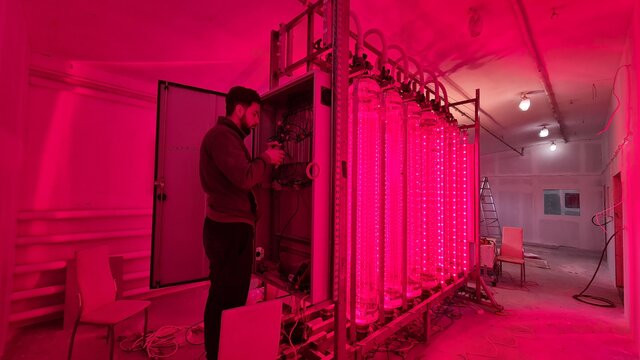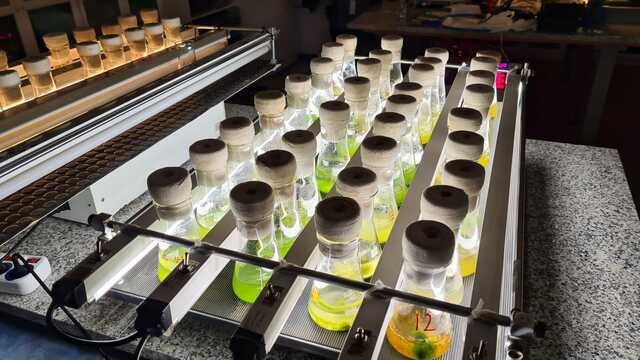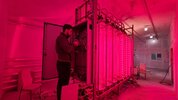What is aquaponics?
It is a combination of two methods of farming and growing live organisms. The first and the oldest one is aquaculture (Latin aqua - water; colere - cultivation, care for, nurture), that is, cultivation of aquatic organisms in an appropriate, dedicated environment. To this end, it uses water reservoirs where nets or cages are placed. The other method is hydroponics, applied in mid-19th century by Wilhelm Knop, a botanist who systematised knowledge on growing plants without soil. In this case, plants are grown in water instead of soil. Owing to this, seedlings are less exposed to parasites and pests as well as to drought. An aquaponic farm is a combination of aquaculture and hydroponics.
How does that system work?
Aquaponics uses closed systems, fish farming in special containers and growing plants in water. They operate based on an accurately composed chain that is monitored and protected against contamination. Plants receive nutrients in the form of natural fertilisers (excrement) from the cultivation of aquatic organisms. It is a very complicated process that is preceded by calculations and metabolic analyses, etc. To make aquaponic cultivation profitable, we need to select elements of the system in the best possible manner. Therefore, at the Water Science Technology Institute in Wroclaw (WSTI) we analyse combinations of organisms (including microorganisms living in bioreactors that, for example, process nitrogen compounds).

Can aquaponic farms save water?
Aquaponic systems consume far less water than the traditional agriculture. On our planet water functions in a closed circuit, so there will be no lack of it as such. However, if we fail to undertake appropriate measures, there will be a lack of clean water as its quality will be low. There can also be too little of it in places it is most needed.
Solutions that will reduce water consumption and prevent the effects of drought are necessary. For example, to farm 1 kg of salmon in a closed circuit, up to 2.5 times less water is consumed compared to traditionally produced beef of that weight. The less water we need, the smaller the risk it is missing for farming. The situation is similar with the cultivation of plants. Closed circuits require several dozen times less water than an open field!
What are other advantages of the aquaponic systems?
We want to produce healthy, genetically unmodified food that contains vitamins and no toxic substances. Today, this sort of production resembles a modern industry. Most of closed farms will be able to do without pesticides completely. Open farms are susceptible to parasites and adverse climate changes. What is important, in closed systems we can farm fish and use no antibiotics, as there are no organisms that can bring any diseases from outside. Finally, aquaponics enables us to significantly reduce the use of fertilisers. For example: fish excrete ammonia, which is not absorbed by plants, therefore it needs to be broken down into nitrogen compounds (in a bioreactor). From there nitrogen compounds are transferred to a hydroponic system and nourish the plants.
How is the system’s sterility controlled?
Through an application of a system of sensors that analyse, for example, water purity. They are used to check whether we do not administer too much feed or whether it does not contain particles that act as a substrate for bacteria development. In that way we prevent penetration of contaminants from, for example, nearby enterprises, which is impossible when it comes to the traditional cultivation.

Do such farms already operate?
There are systems of that type that produce massive amounts of food of very good quality. Recently, Future Farming began operating in Czechia. It is one of the largest aquaponic farms in Europe. Food4Future is currently building one of Poland’s first aquaponic systems that intends from the very beginning to produce and sell instead of only conducting research.
What sort of infrastructure is needed to allow development of aquaponic farms?
Automation of the entire farming process is indispensable as well as safeguarding uninterrupted supply of electricity and emergency oxygen diffusers. What is also needed is feed production plants, banks from where microorganisms to be used in reactors and fish could be acquired. Companies producing sterile seeds are also necessary. And of course, processing plants must be there.
At Water Science Technology Institute we create conditions that allow training staff that will be able to deal with all these technological challenges around aquaponics. Therefore, we collaborate with partners from Future Farming and Norway and we are planning to organise, for example, student and scientist exchange programmes in the future.








